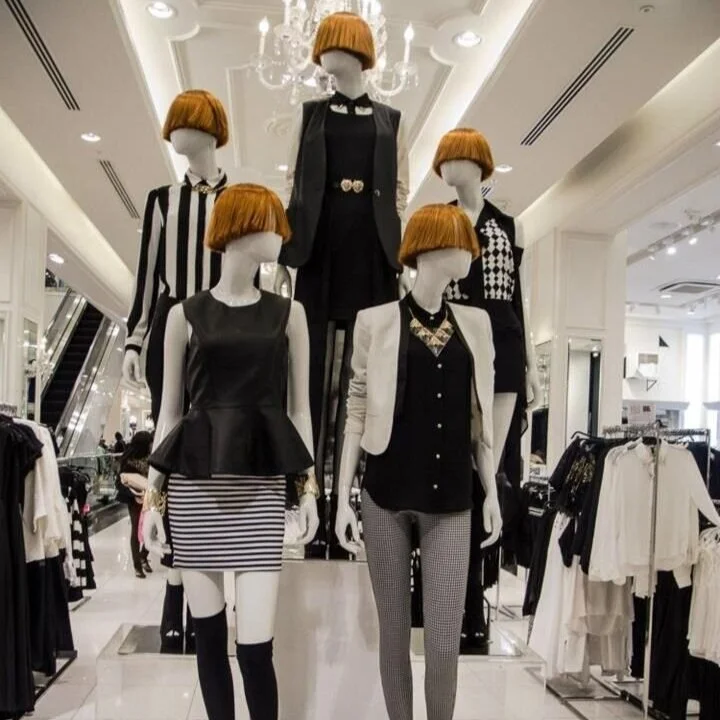Fast Fashion Explained

BY ALEXIA OERTER
The fashion industry has always been harmful to our resources but there has definitely been a rise in awareness and responsibility in the last few years, as it becomes more and more detrimental every day. The fashion industry is known to violate human and animal rights, as well as to put the health and safety of the workers, and wearers, in danger. Fast Fashion, as the concept of today’s fashion consumerism, is a direct agent in the effects of the industry.
Fast Fashion can be defined as a method of production and consumerism that is often characterised by fast production, supply and demand, low quality and cheap prices. The styles are stolen from high fashion catwalks and celebrity culture and is the answer to a demand for instant satisfaction. Trends are so quick to come and go that clothing brands feel pressured to stay on top of them to attract a maximum of customers.
Big chains like ZARA and H&M pride themselves on the fast renewal of their collections, receiving deliveries of new pieces every week, or even several times a week. This pushes consumers to buy more because the culture of fast fashion creates a sense of urgency. If consumers like an item, they feel the need to purchase the piece right away since it will no longer be available within days. And when trends inevitably change within weeks, shoppers buy even more to update their wardrobe.
This fast renewal of clothing is attractive to customers because it means that, even though big textile groups such as ZARA are accessible all over the world, not everyone will have bought the same item. It still adds up to a lot of people buying the same clothes, of course, just less than it would be without this constant renewal of collections.
One of the main attractive characteristics of Fast Fashion is the low cost. Unfortunately, to be cheap for the customer, other costs of production need to be cut. The wages of the workers are often below the legal limit and the safety regulations are overlooked, as shown by the Rana Plaza Collapse in 2013, when a textile factory collapsed in Bangladesh, killing more than 1,000 people. Not to mention that in certain countries, it has become cheaper to produce real animal fur than faux fur because of the lack of regulations and inhumane treatment of the animals. In 2017, it was revealed that some stores had been unknowingly making clothes with real fur passed as faux-fur in the earlier stages of production.
The cut in costs of production is also damaging to the environment. The cheap textile dyes and synthetic fibres have become a substantial clean water polluter, right after agriculture. Polyester, the most popular, cheap textile used in Fast Fashion, derives from fossil fuels, which contributes to global warming. The microfibres of the material shed when washed and add to the amount of plastic found in our oceans. The use of natural fabrics such as cotton may seem like a natural solution, but enormous amounts of water and pesticides are used in developing countries to produce this material, which takes a toll on natural resources. Some garments even contain high levels of lead which can intoxicate the people exposed to them including the workers but also the wearers, as the skin can absorb the chemicals.
Not only Fast Fashion makes people, animals and the environment suffer, but the low quality of the clothes, in addition to the quantity and speed of production, encourages a “throw-away” culture that perpetuates Fast Fashion and creates monumental textile waste. Whatever bargain is bought at high street stores, the clothes will inevitably wear out and be thrown away after a few wears with only a small percentage being recycled. Millions of items are sent to landfills, where non- biodegradable fabrics can remain buried for up to 200 years, or incinerated, which generates air pollution.
In recent years, different associations have made it their goal to raise consciousness around the harm made by the Fashion industry. Examples include the Green Peace “Detox The Catwalk” campaign of 2016, or the documentary “The True Cost” directed in 2015 Andrew Morgan. The Slow Fashion concept has also emerged as part of the global Slow Movement, and more brands adopt its ethics every day. However, if the capitalist demand for constant consumerism doesn’t decrease, steps towards sustainability will be overshadowed by the dire impacts of Fast Fashion.
Tips to spot a Fast Fashion brand :
Low cost of the finished product.
Clothes are manufactured in countries where labour is cheapest.
Quick renewal of collections and constant deliveries of new items.
Limited quantity of each item.
Low quality of fabrics and production, shown by the item degrading after just a few wears.
Trends stolen from catwalks and celebrity culture, as well as very short time between their first appearance, their production by Fast Fashion companies and availability on the shelves.